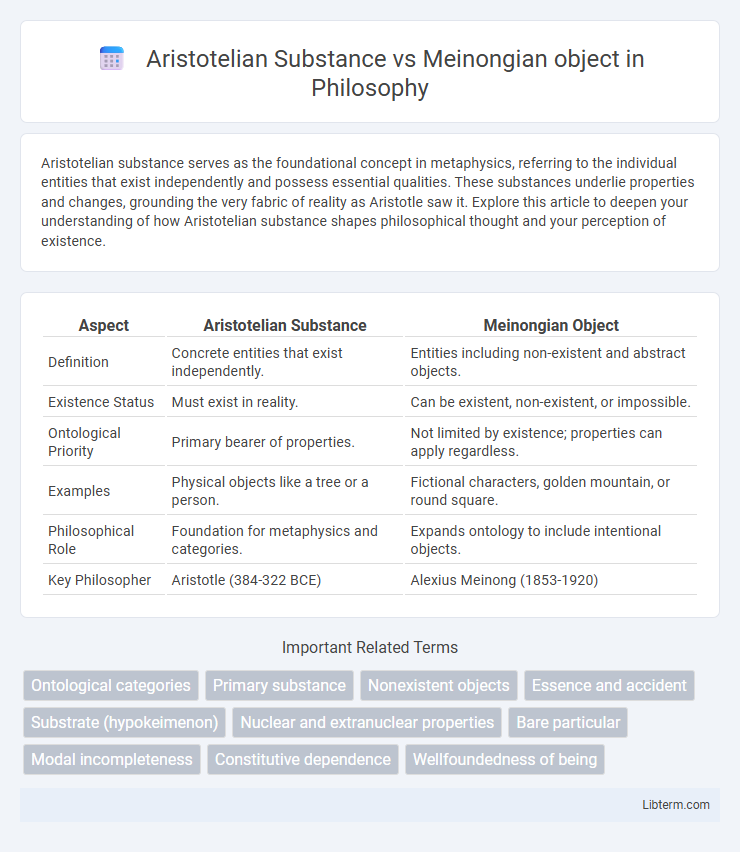Aristotelian substance serves as the foundational concept in metaphysics, referring to the individual entities that exist independently and possess essential qualities. These substances underlie properties and changes, grounding the very fabric of reality as Aristotle saw it. Explore this article to deepen your understanding of how Aristotelian substance shapes philosophical thought and your perception of existence.
Table of Comparison
| Aspect | Aristotelian Substance | Meinongian Object |
|---|---|---|
| Definition | Concrete entities that exist independently. | Entities including non-existent and abstract objects. |
| Existence Status | Must exist in reality. | Can be existent, non-existent, or impossible. |
| Ontological Priority | Primary bearer of properties. | Not limited by existence; properties can apply regardless. |
| Examples | Physical objects like a tree or a person. | Fictional characters, golden mountain, or round square. |
| Philosophical Role | Foundation for metaphysics and categories. | Expands ontology to include intentional objects. |
| Key Philosopher | Aristotle (384-322 BCE) | Alexius Meinong (1853-1920) |
Introduction to Aristotelian Substance and Meinongian Object
Aristotelian substance is defined as a fundamental entity with both form and matter, serving as the primary being underlying all properties and change in classical metaphysics. Meinongian objects, by contrast, encompass not only existent entities but also non-existent and even impossible objects, broadening the ontological domain beyond traditional substance theory. This distinction highlights Aristotle's focus on concrete reality versus Meinong's expansive approach to objects as intentional contents of thought.
Historical Background and Philosophical Context
Aristotelian substance, rooted in Aristotle's Metaphysics, serves as the primary category of being, embodying individual entities that exist independently and possess essence and form. Meinongian objects emerge from Alexius Meinong's early 20th-century theory, expanding ontology to include non-existent and incomplete entities, such as fictional or contradictory objects, which challenge traditional existence criteria. The historical transition from Aristotle's focus on concrete, actual substances to Meinong's inclusion of heterogenous entities reflects shifts in philosophical context addressing the nature of existence, reference, and intentionality.
Defining Aristotelian Substance: Core Principles
Aristotelian substance centers on entities that exist independently and serve as the fundamental bearers of properties, emphasizing their primary ontological status. These substances are defined by their essential qualities, which determine their identity and persistence through change. In contrast to Meinongian objects, which include non-existent and impossible entities, Aristotelian substances strictly pertain to concrete realities with actual existence.
Exploring Meinongian Objects: Objects Beyond Existence
Meinongian objects encompass entities that do not exist in reality but maintain a status as objects within the realm of intentionality, contrasting with Aristotelian substance which strictly pertains to existing entities with independent being. These objects, including fictional characters and impossible objects, challenge classical ontology by expanding the scope of what can be meaningfully discussed and thought about without requiring actual existence. Exploring Meinongian objects reveals a nuanced framework for understanding reference, intentionality, and the ontological commitments of language beyond the constraints of existence.
Ontological Commitments: Substance vs. Object
Aristotelian substance refers to fundamental entities that exist independently and possess essential properties, serving as the primary bearers of attributes within reality. Meinongian objects encompass a broader ontological category, including both existent and non-existent entities, such as fictional or impossible objects, emphasizing ontological commitment to a diverse range of objects regardless of their actual existence. The distinction in ontological commitments highlights Aristotelian emphasis on concrete substances as foundational, whereas Meinongian ontology commits to a more inclusive universe of objects, extending beyond mere existence.
Identity, Persistence, and Change in Both Frameworks
Aristotelian substance is defined by its identity as a concrete, unified entity that persists through change by maintaining an underlying essence, enabling it to undergo accidental alterations without losing its core nature. Meinongian objects extend beyond actual existence to include non-being entities, where identity is determined by properties rather than essence, allowing for objects that can change or persist in a state independent of empirical reality. In Aristotelian ontology, persistence hinges on substance's continuity, while Meinongian theory treats identity and change more flexibly, accommodating incomplete or non-existent objects within its framework of intentionality and varying modes of existence.
Reference and Nonexistent Objects: The Meinongian Perspective
Meinongian objects challenge traditional reference theories by including nonexistent entities, such as fictional characters or impossible objects, within ontology. Unlike Aristotelian substance, which requires actual existence for reference, Meinongian theory allows objects to be referenced regardless of their existential status, expanding the scope of intentionality and semantic discourse. This approach resolves paradoxes related to nonreferring terms by positing a realm of objects that have properties without existing in reality.
Critiques and Defenses of Aristotelian Substance
Aristotelian substance faces critiques for its perceived metaphysical rigidity and difficulty accounting for non-existent or abstract entities, challenges addressed by Meinongian objects which allow for a broader ontological range including non-being. Defenses of Aristotelian substance emphasize its foundational role in classical metaphysics, asserting that substance as primary being grounds identity, change, and causation more robustly than Meinongian ontology. Contemporary philosophers often defend Aristotelian substance by refining its conceptual framework to accommodate abstract objects as dependent particulars rather than abandoning substance ontology entirely.
Applications in Contemporary Metaphysics
Aristotelian substance, defined as a fundamental entity underlying properties, is pivotal in contemporary metaphysics for grounding discussions on identity and persistence through change. Meinongian objects, encompassing non-existent or impossible entities, expand metaphysical frameworks by enabling analysis of intentionality, fiction, and non-being. This contrast facilitates nuanced debates on ontology, where Aristotelian substance anchors existence while Meinongian theory challenges and enriches the conceptualization of objects beyond traditional existence.
Comparative Analysis and Future Directions
Aristotelian substance, defined as an independent entity with a distinct essence, contrasts with Meinongian objects, which include non-existent entities characterized by properties without presupposing existence. Comparative analysis highlights substance's foundational role in classical metaphysics versus Meinong's broader ontology accommodating impossible or non-being objects. Future research may explore integrating Meinongian object theory into contemporary metaphysics and ontology, enhancing understanding of existence, identity, and conceptual frameworks beyond traditional substance metaphysics.
Aristotelian Substance Infographic

 libterm.com
libterm.com